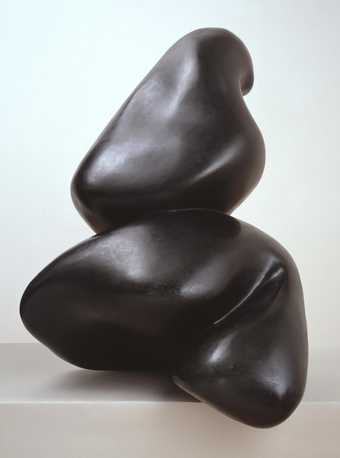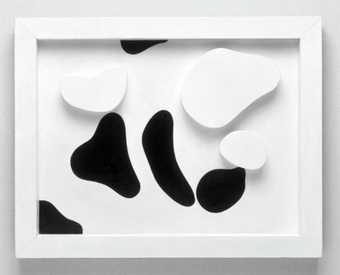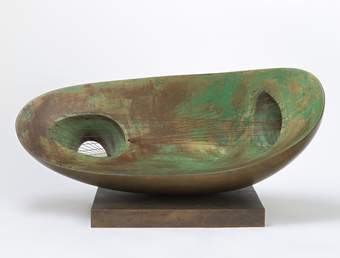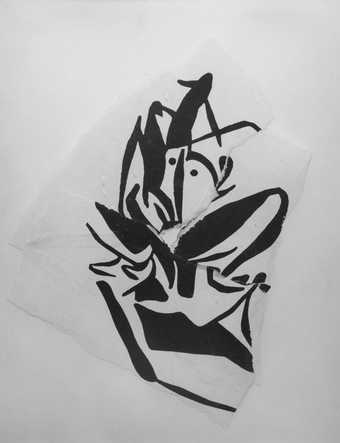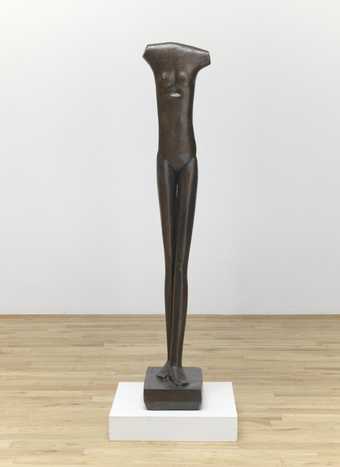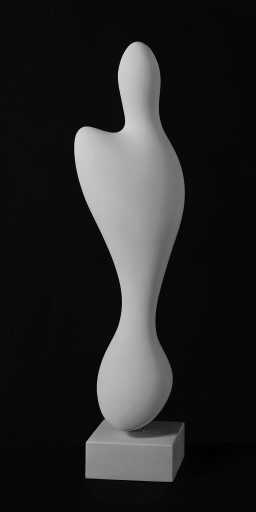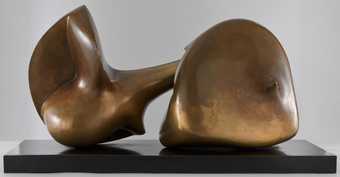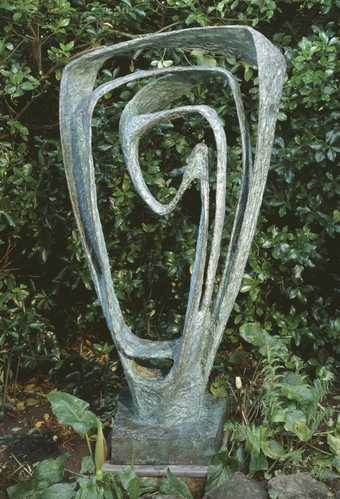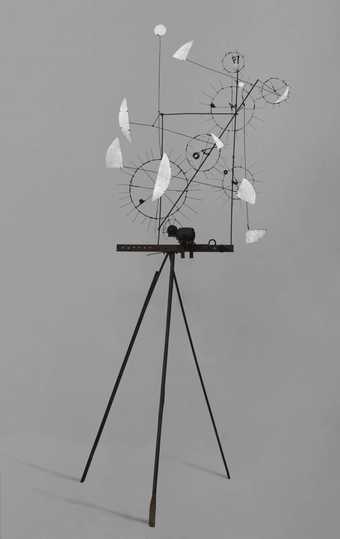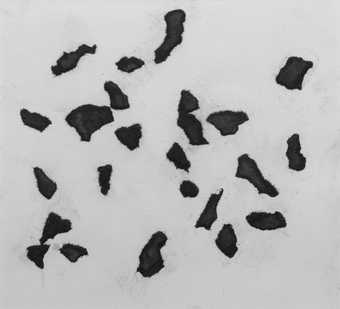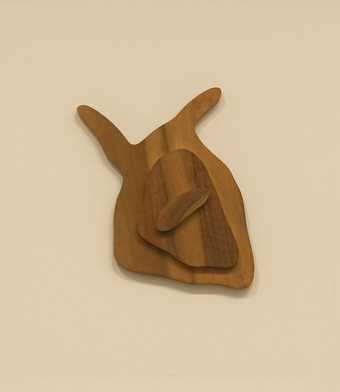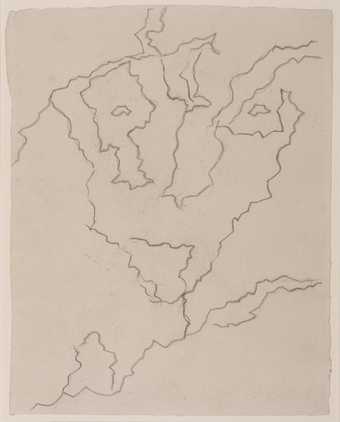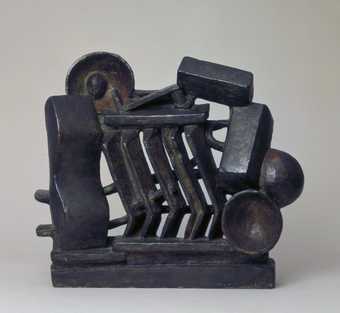
Not on display
- Artist
- Jean Arp (Hans Arp) 1886–1966
- Original title
- Sculpture à être perdue dans la forêt
- Medium
- Bronze
- Dimensions
- Objects: 90 × 222 × 154 mm, 60 × 120 × 100 mm and 65 × 55 × 93 mm (weight 4.6 kg)
- Collection
- Tate
- Acquisition
- Accepted by HM Government in lieu of tax and allocated to the Tate Gallery 1986
- Reference
- T04854
Display caption
In the 1920s and 1930s Arp developed a type of biomorphic sculpture that suggested a parallel between artistic creativity and creation in nature. The shapes in his work evoke worn pebbles, buds and other natural forms. He created these sculptures using a quasi-automatic process of sanding away at a plaster model until he was satisfied with the shape. ‘I work until enough of my life has flowed into its body’, he said. His efforts to link his work with nature included placing sculptures in the forest near his home at Meudon, where they could be discovered by unsuspecting passers-by.
Gallery label, November 2012
Does this text contain inaccurate information or language that you feel we should improve or change? We would like to hear from you.
Catalogue entry
T04854 Sculpture To Be Lost in the Forest 1932, cast c. 1953–8
Sculpture à être perdue dans la forêt
Bronze in three parts 90 × 222 × 154 (3 1/2 × 8 5/8 × 6 1/4), 60 × 120 × 100 (2 1/8 × 4 3/4 × 4), 65 × 55 × 93 (2 1/2 × 2 1/8 × 3 5/8); overall size 115 × 220 × 154 (4 1/2 × 8 5/8 × 6 1/16)
Not inscribed; stamped foundry mark ‘SUSSE FONDEUR PARIS’ on underside of largest part Accepted by the Commissioners of Inland Revenue in lieu of tax and allocated 1986
Prov: Given by the artist c. 1960 to Paule Vézelay, who died 1984; offered by her executor to the Commissioners of Inland Revenue
Lit: Stefanie Poley, Hans Arp: Die Formensprache im plastischen Werk, Stuttgart 1978, pp.67–8; Margherita Andreotti, The Early Sculpture of Jean Arp, Ann Arbor 1989, pp.206, 275. Also repr. ?Carola Giedion-Welcker, Jean Arp, 1957, p.48, as ‘To Be Exposed in the Woods (sculpture in three forms)’ (unspecified cast); National Art Collections Fund Magazine, Autumn 1987, p.19, as ‘To Be Lost in the Forest’
‘Sculpture To Be Lost in the Forest’ is one of an edition of five sculptures, made of unpatinated bronze which is dull gold in colour. It was made from an original plaster, dating from c.1932, which Arp gave c.1938 to a friend, the British abstract artist Paule Vézelay who was then living in Paris. At Arp's request, Vézelay returned the plaster to Arp c.1953 to allow an edition of bronze sculptures to be made. In a letter to the compiler dated 24 July 1992, Greta Ströh of the Fondation Arp at Clamart-Meudon writes that it is likely that three casts were made at the Susse foundry shortly after Arp received the plaster. Certainly, a bronze example was shown in Begründer der modernen Plastik, Kunsthaus, Zürich, Nov.–Dec. 1954 (no.2, listed as available for sale). A fourth cast is known to have been made in June 1958; and Arp's second wife, Mme Marguerite Hagenbach-Arp, arranged for a fifth to be cast in December 1972. More recently, Johannes Wasmuth, Director of the Verein Hans Arp und Sophie Taeuber-Arp at Rolandseck, Germany, authorised the casting of an ‘exemplaire d'artiste’ at the Rudier foundry in January 1983, from a plaster cast which belonged to Mme Marguerite Hagenbach-Arp until at least 1977 and is now in the collection of the Verein at Rolandseck.
An illustration of what appears to be the original plaster version of this sculpture was published in a Danish periodical entitled Konkretion (Copenhagen, vol.1, no.9, 1935, as ‘Concretion humaine’). A year later, the same work was reproduced in a Polish exhibition catalogue (Hans Arp, exh. cat., Museum of Lodz 1936, p.11, as ‘Configuration’). It has to be remembered that Arp may have made more than one plaster version of this sculpture in the early 1930s, although he himself later described the plaster owned by Paule Vézelay as unique (letter to Vézelay dated 24 Sept. 1953, private collection). In the 1950s Arp sanctioned the production of at least one plaster cast, probably more, from the work owned by Paule Vézelay (now in a private collection, London) at the time of its casting into bronze. The Susse foundry in the 1950s would have needed to have made one cast in order to make the bronze edition; and it is known that Arp, who liked to rework earlier pieces, often had two or three copies made of sculptures which were being cast in bronze. In 1971 Mme Hagenbach-Arp presented a plaster version of T04854 to the Kröller-Müller Museum, Otterlo. This is presumed to date from the 1950s; and it is identified as a plaster cast, rather than an original, by Andreotti (1989, p.275). As has been seen, the Verein at Rolandseck possesses another plaster cast. An example was made in black granite in the mid to late 1950s, a period when Arp, who was not a skilled stone mason himself, could afford to employ stone masons to copy his work (the present location of this piece, which was bought from the artist by the Sidney Janis Gallery, New York, in the late 1950s is unknown).
The original plaster version of T04854 was one of the earliest of a series of Arp's fluid-form sculptures, sometimes known under the generic title of ‘Concretions’. It is also one of a small number of multi-part works with moveable pieces. The earliest of these is thought to have been the four-part sculpture, ‘Head with Annoying Objects’ (Silkeborg Museum, Denmark, repr. Andreotti 1989, fig.78). This work is traditionally dated 1930, but is more likely to have been executed in the summer of 1932: in an article of 1933 Christian Zervos, editor of Cahiers d'Art, wrote regarding this work, ‘We publish here a sculpture by Arp that shows us the artist's new direction since last summer’ (quoted in Andreotti 1989, p.269). The other multi-part works which, along with the plaster version of T 04854, are thought to have been executed in mid and late 1932 are: ‘Navel and Two Thoughts’ (Musée d'art moderne, Strasbourg, repr. Andreotti 1989, fig.80: the two smaller pieces, resting on the third, appear very similar in shape to those of T 04854, but are both smaller in size, 9 1/2 × 5 4/5 × 3 1/2 in and 5 1/2 × 2 × 3 1/2 in respectively); another work, also known as ‘Sculpture To Be Lost in the Forest’, but consisting only of two parts (present whereabouts of original plaster unknown, repr. Andreotti 1989, fig. 81); and ‘Concretion’, a four-part work, which has sometimes been dated 1933 (present whereabouts of the original plaster unknown, repr. ibid., fig.83). Arp is known to have executed also a small number of multi-part sculptures in 1933. However, there may have been more such works than is currently supposed: undated photographs in the archives of the Fondation Arp at Clamart-Meudon show two multi-part sculptures of unknown title, which appear to date from the early 1930s; and a photograph of Arp's studio, taken c.1960, shows that throughout his life he kept a small number of plaster pieces, similar to those made in the early 1930s, which may have been elements of either unknown or abandoned works (repr. Ernst Scheidigger, Zweiklang, Zürich 1960, p.71).
Arp first experimented with the curvilinear form language which was to dominate his mature work during the First World War. From c.1917 he made a number of wooden reliefs, using flat pieces of wood which had been cut into irregularly rounded shapes. These were produced by a carpenter following Arp's instructions, but were assembled, and sometimes painted, by the artist himself. The reliefs of the late 1910s and 1920s expressed many of the themes developed in the later plaster sculptures: a rejection of traditional, illusionistic art, and the ‘vices’ of individualism, egotism and deception that Arp associated with it; an exploration of the signifying potential of abstract art; and the establishment of a parallel between his creative work as an artist and creation in nature.
Arp later said that, as early as 1917, he had considered making his organically shaped wall-hung reliefs free-standing in order to give them an ‘independent existence’ (quoted in Andreotti 1989, p.30); but his only known freestanding sculptures of the late 1910s were geometric and symmetrical in nature. From the mid-1920s, however, Arp, who was then based in Paris, became increasingly interested in producing free standing sculptures. In 1926, for example, he made ‘Head-Stabile’ (repr. ibid., fig.21), which consists of an irregularly rounded flat piece of wood (the ‘head’), standing vertically on a flat base. He later began to use wooden forms which had been turned on machinery (and were consequently symmetrical). Multi-part sculptures such as ‘Personages’, 1931, which included two turned forms and an upright flat piece, resting on a circular base (Fondation Arp, Clamart-Meudon, repr. ibid., fig.28), introduced a new element of spatial interaction between the different parts within the conventional space of the work's table-top format.
Arp's new interest in three-dimensional space may have been partly inspired by the emphasis on quasi-traditional perspectival space in the Surrealist paintings of Yves Tanguy, René Magritte or Salvador Dalf. It might also be seen as a response to Picasso's drawings and paintings of ‘bathers’, executed at Dinard in the summer of 1928. These showed figures composed of abstract sculptural shapes, set in a naturalistic space. The multi-part sculptures of Alberto Giacometti may also have been influential, although his ‘Suspended Ball’, 1930–1 and ‘Project for a Square’, 1931 (repr. William Rubin, Dada and Surrealist Art, 1978, figs. 25, 27), have a disturbing, even nightmarish, quality remote from the whimsy and detachment of Arp's work.
Arp began to work in plaster in 1929 after an interval of many years (his very early sculptures, executed in the 1900s, had also been made in plaster). Two monstrously deformed plaster heads, now lost, are known from reproduction in the Belgian periodical Variétés (repr. Andreotti 1989, figs. 57–8). Arp permitted his subsequent plaster works to be exhibited and reproduced only from 1933, which suggests that it took some time for him to be confident about the new direction in his work. This may have been partly due to the fact that, while a carpenter carved the pieces of his wooden reliefs, Arp moulded and sanded his plaster works himself. Andreotti writes, ‘Before feeling entirely comfortable in this new medium, Arp may have had to overcome a resistance, stemming from his hard-won opposition to naturalism, to the use of modelling and the traditional materials of plaster, marble or bronze’ (ibid., pp.148–9).
As a medium, plaster had the advantage of being easy to work and fairly durable. It also allowed the artist to work slowly and meditatively. Arp would build up a form in plaster, with or, more usually, without an armature; alternatively, he would use a piece of plaster lying in the studio as a starting point. He would then begin to form the piece by rasping and sanding away the plaster until he was satisfied with the shape. According to Arp (quoted ibid., p.149), this technique permitted him to work in a quasi-automatic fashion:
I intensify the curve or the contrast, and this engenders new forms. Among these new forms, some-for example-grow more rapidly and more strongly than others. I let them grow until the original forms have become secondary and almost expressionless. Finally I suppress one of the secondary and expressionless forms so that the others become more apparent. It often takes me months, years to complete a sculpture. I work until enough of my life has flowed into its body.
In the early 1930s Arp seems to have felt that plaster was as important as more durable and costly media. His plaster works were exhibited, sold, given as gifts, and photographically reproduced. In the case of the multi-part sculptures of the early 1930s, which were intended to be handled and rearranged by the viewer, he may have welcomed the lightness and informality of plaster. It was also cheap; but, as Andreotti has pointed out, Arp could have afforded to have cast his early works in bronze earlier than he did, if cost alone had been the issue. However, as he became attracted to the idea of the potential interchangeability of his created forms and those of nature, he soon preferred to use natural stone; and by 1937, if not earlier (see Andreotti 1989, p.151), Arp began to cast some works in bronze.
Using irregularly curvilinear forms that evoked weathered pebbles or swollen buds, Arp no longer felt obliged to create a special base or environment for his works: they were to find their place in nature. The importance that the idea of nature was to assume in Arp's work had been anticipated in an early multi-part sculpture, ‘Forest-Tables’, c.1928–31 (collection I.M.A., repr. ibid., fig.26). In this wooden work, two flat ‘leaf’ forms lie on cylindrically shaped pieces which, in turn, stand on a circular base, along with a third ‘leaf’ form. Through metonomy, these ‘leaves’ can be thought of as standing for all the leaves on the ‘trees’; and the work as a whole appears to represent, in a playful and distilled fashion, a forest. Furthermore, the ‘fallen leaf’ on the sculpture's base may allude to the natural cycle of growth and decay. Andreotti writes that this was one of the very first of Arp's freestanding sculptures to ‘have the natural landscape as its sole subject-that is, unconnected with a representation of the human figure’ (ibid., p.121). ‘Forest Tables’ and the plaster sculptures of the early 1930s pioneered a trend-explored also by such sculptors such as Henry Moore, Barbara Hepworth and Alexander Calder - of making the processes of nature the subject of sculpture.
Arp used the irregularly rounded shapes of his sculptures to express a fluid balance of forces that he felt both characterised natural forms and symbolised the idea of nature as the seat of a non-rational, non-mechanistic order. Like many Parisian avant-garde artists in the early 1930s, he was particularly fascinated with stones; and the shapes of many of his sculptures of this period resemble the weatherworn shapes of pebbles, found at waysides or on beaches. In poetic writings of this period Arp made explicit references to stones. In 1931, for example, he wrote, ‘A sculpture that has not had an object for a model is as concrete and sensual as a leaf or a stone’; and in several verses of the poem ‘L'air est une racine’, published in 1933, he compared stones to a range of other forms, including entrails, branches of water, and clouds (quoted in Andreotti 1989, p.199). More generally, Arp intended the fluid shapes of his Concretion sculptures to signify the processes of nature. As he later wrote:
Concretion signifies the material process of condensation, hardening, coagulating, thickening, growing together. Concretion designates the solidification of a mass. Concretion designates curdling, the curdling of the earth and the heavenly bodies. Concretion designates solidification, the mass of the stone, the plant, the animal, the man. Concretion is something that has grown.
(‘Looking’, in James Thrall Soby, ed., Arp,
New York 1958, p.15)
In the mid-1930s he titled a number of Concretion works ‘Stone Formed by Human Hand’, as if they would be otherwise indistinguishable from natural forms.
There is no evidence that T04854 was known by the title ‘Sculpture To Be Lost in the Forest’ until it was cast in bronze in the mid-1950s (a cast, identified as being for sale, was exhibited with the French version of the title in 1954, see Begründer der moderner Plastik, exh. cat., Kunsthaus, Zürich, 1954, no.2, collection not specified). As has been seen, a plaster version of T04854 was reproduced in 1935 with the title ‘Concretion humaine’, and, a year later, as ‘Configuration’. Arp generally favoured simple titles in the early and mid-1930s, a period in which he helped to promote the cause of the non-objective art through the organisation Abstraction-Création, of which he was a founder member. It is possible that, in the 1950s, Arp chose a new title for the bronze to distinguish it from the plaster original, or to make explicit a link with a multi-part plaster of that title, also made in 1932 (repr. Andreotti 1989, fig.81). If, as seems likely, the title of T05854 was settled upon only in the 1950s, it might be seen as reflecting Arp's willingness in this later period to explain more fully and plainly than before his vision of the relationship between his art and nature. It was in 1954, for example, that he wrote:
Sculpture should walk on the tips of its toes, unostentatious, unpretentious, and light as the spoor of an animal in snow. Art should melt into and even merge with nature itself. This is obviously contrary to painting and sculpture based on nature. By so doing, art will rid itself more and more of self-centredness, virtuosity and absurdity.
(quoted in Marcel Jean, ed., Jean Arp: Collected French Writings, trans. Joachim Neugroschel, 1963, p.327)
In fact, Arp is known to have placed one or more sculptures in the forest surrounding his home at Meudon in 1935. He and a friend, the poet and painter Camille Bryen, put plaster sculptures near trees and bushes in the Forest of Meudon, where, in hiding, they would wait to see the shocked reactions of people passing by (Greta Ströh, ‘Kurzbiographie Arp’, in Hans Arp: Skulpturen, Reliefs, Gouachen, exh. cat., Galerie Neher, Frankfurt-am-Main 1987, p.13). In a letter to the compiler dated 3 August 1992, Greta Ströh wrote that Bryen's object was called ‘Le Sein de la forêt’ (‘The Breast of the Forest’). Arp's idea of ‘losing’ works in a forest may be thought, therefore, to date from this episode. (While the French title of T04854 suggests the idea of being ‘lost’ in the forest, the German title, ‘Im Walde auszusetzen’ implies only that the work should be ‘placed’ in a wood. As it is not clear which title should have priority, it has been decided to use a translation of the better known French title.)
The forest was a perennial theme in Arp's writings and art works. One his earliest poems was ‘In the Forest’, 1903. Arp later placed it at the beginning of the first volume of his Collected Poems, perhaps because of the theme's significance for his later work. Andreotti (1989, pp.122–3) writes:
As Arp grew up in Strasbourg, with the famous Black Forest nearby, the mythic and symbolic dimensions of the forest must have loomed large in his imagination, reinforced as they were by his read ing of German Romantic poetry and fairytales, and by his special sensitivity to ‘the powerful poetry of nature’. Arp's extended stays in Switzerland, a country of many forests, and particularly his decision to build a house and live right on the border of the forest of Meudon, could only have strengthened over the years Arp's appreciation of the forest as a symbol of nature, a nature from which modern man was increasingly and dangerously distancing himself ... A measure of the importance of the forest theme for Arp is its recurrence throughout his career, not only in his poetry but also in his visual work, starting with the ‘Forest’ or ‘Earthly Forms’, reliefs of the Zürich Dada years, continuing with the ‘Sculptures to Be Lost in the Forest’ of the early 1930s, and culminating in the ‘Forest-Wheels’ of Arp's last years.
Arp gave T04854 c. 1938 to the young English painter Paule Vézelay, as a token of their friendship (this is stated by Vézelay in a letter, now in a private collection, to Marguerite Hagenbach-Arp, dated 4 October 1974). Vézelay had exhibited with the Surrealists, a group with which Arp had been closely associated, before joining Abstraction-Création, in the early 1930s. She became close friends with Arp and his first wife Sophie Taeuber-Arp, and went on holiday with them. In an unpublished poem, entitled ‘To Jean Arp’, and dated 12 August 1939, Vézelay wrote of ‘these rare volumes’ of Arp's sculptures: ‘composed in solid form | they shape a poet's thought, | both sense and eye | love these dimensions’ (MS in private collection); and in a published article she praised the formal purity of his work, as well as its richness of associations (see ‘Jean Arp: Sculptor and Poet’, World Review, no.17, Sept. 1949, pp.61–4).
The story of the casting of the plaster of T04854 into bronze can be pieced together from correspondence in a private collection. On 24 September 1953 Arp asked Vézelay, ‘Could you do me a big favour? The small plaster I gave to you some time ago is unique and very fragile. I should like to have it cast in bronze for you. Could you bring the little pieces to Paris?’ (Vézelay frequently stayed with the Arps in the 1950s.) The casting of the first four bronzes of T 04854 was completed by mid-1958, but Vézelay had yet to receive her promised cast by 4 December 1959, when she wrote to Mme Hagenbach-Arp, ‘Please let me know if you have the bronze forms. I have waited so long for it [sic]’. In another letter, dated 4 October 1979, Vézelay made it clear that she had understood that only three casts were to be made. She wrote:
I want to clear up what seems to have been a misunderstanding about the sculpture Jean gave me while Sophie was still alive, that was in about 1938. After the war I was in Paris for an exhibition at Jeanne Bucher's gallery, and Jean asked me to bring back this sculpture (in three pieces) so that he could have three castings made - one for a collector - one for himself and one for me. Of course I agreed. Later on I was surprised to see a reproduction of this work - stated to be no:5. I did not know there was an edition of 5. Of course Jean had a perfect right to make the casting since he owned the copyright.
She had asked if another cast could be made, ‘so that I would have one and one could go to the Tate Gallery because Jean had told me he would like the Tate to have mine eventually’. However, a further cast was not made for her.
Published in:
Tate Gallery: Illustrated Catalogue of Acquisitions 1986-88, London 1996
Explore
- abstraction(8,615)
-
- from recognisable sources(3,634)
-
- organic(827)
- non-representational(6,161)
-
- irregular forms(2,007)
- universal concepts(6,387)
-
- environment / nature(315)
- sensuality(24)
You might like
-
Jean Arp (Hans Arp) Pagoda Fruit
1949 -
Jean Arp (Hans Arp) Constellation According to the Laws of Chance
c.1930 -
Dame Barbara Hepworth Landscape Sculpture
1944, cast 1961 -
Jean Arp (Hans Arp) Torn-Up Woodcut
1920–54 -
Alberto Giacometti Walking Woman I
1932–3–1936, cast 1966 -
Jean Arp (Hans Arp) Winged Being
1961 -
Henry Moore OM, CH Two Piece Sculpture No.7: Pipe
1966, cast date unknown -
Dame Barbara Hepworth Garden Sculpture (Model for Meridian)
1958 -
Jean Tinguely Metamechanical Sculpture with Tripod
1954 -
Jean Arp (Hans Arp) According to the Laws of Chance
1933 -
Jean Arp (Hans Arp) Impish Fruit
1943 -
Jean Arp (Hans Arp) Danger of Death
1954 -
Jean Arp (Hans Arp) Moustaches
c.1925 -
Kurt Schwitters Red Wire Sculpture
1944 -
Alberto Giacometti Composition (Man and Woman)
1927, cast ?1964

